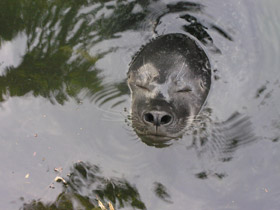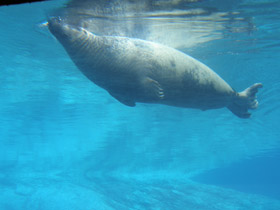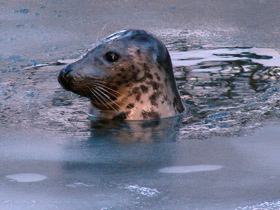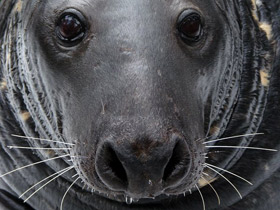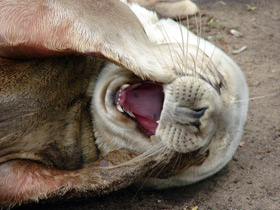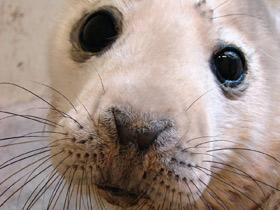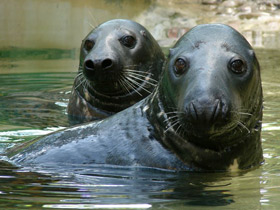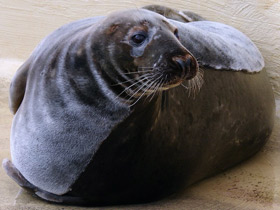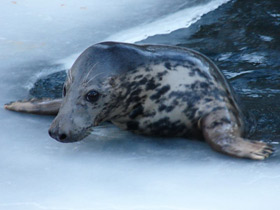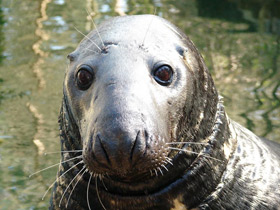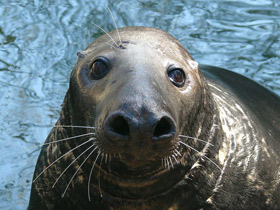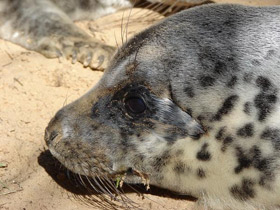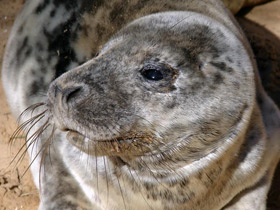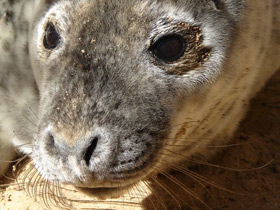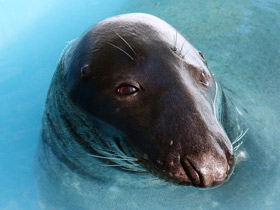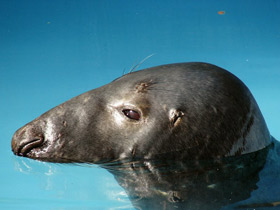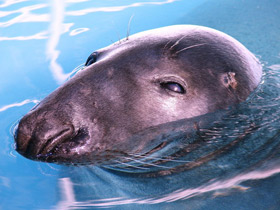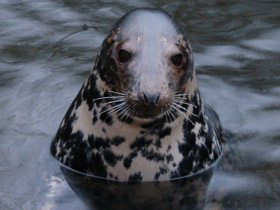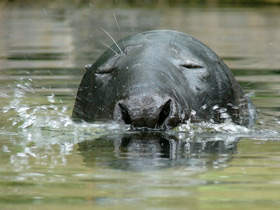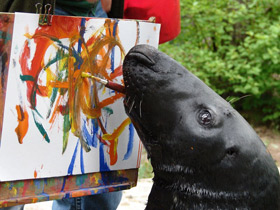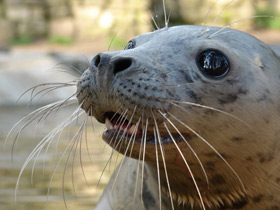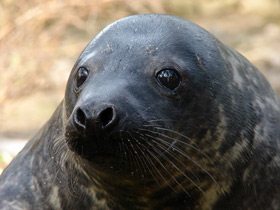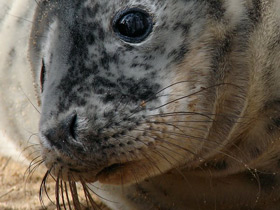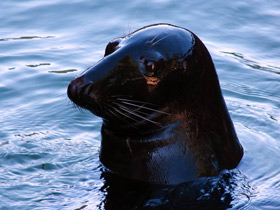The grey seal (Halichoerus grypus)
The grey seal (Halichoerus grypus) is a large seal of the family Phocidae, which are commonly referred to as "true seals" or "earless seals". The only species classified in the genus Halichoerus, it is found on both shores of the North Atlantic Ocean. In Latin, Halichoerus grypus means "hook-nosed sea pig". Its name is spelled gray seal in the US; it is also known as Atlantic seal and the horsehead seal.
Description and nutrition
Halichoerus grypus is a species of pinniped mammal of the family Phocidae relatively common in North Atlantic waters. It is the only species of its genus.
Hairypus grypus is a large representative of the true harbour seals, with a body length of 2-3 m and a weight of 150-300 kg. Seals feed mainly on fish, but invertebrates are rarely found in their stomachs and, in small quantities, some types of squid, crabs and shrimps. In the Baltic Sea these seals may eat cod, herring, eel, sea bream and salmon-like fish, and in the waters off the Murmansk coast - cod and pinnace.
Habitat
Naalichoerus grypus is mainly distributed in the temperate North Atlantic, and is found virtually throughout the Baltic Sea, including the Gulf of Finland, the Gulf of Riga and parts of the Gulf of Bothnia. Outside the Baltic Sea, in the eastern Atlantic, grey seals are found from the English Channel to the Barents Sea, inhabiting the coastal waters of Great Britain and Ireland, Orkney, the Hebrides, Shetland and the Faroe Islands, and are found off the coasts of Iceland, central and northern Norway. In Russia, these seals inhabit the Murmansk coast from the Norwegian border to the western entrance of the White Sea, as well as many islands in coastal waters. Throughout the year, these pinnipeds live in low-salinity seawater.
Diet
The grey seal feeds on a wide variety of fish, mostly benthic or demersal species, taken at depths down to 70 m (230 ft) or more. Sand eels (Ammodytes spp) are important in its diet in many localities. Cod and other gadids, flatfish, herring, wrasse and skates are also important locally. However, it is clear that the grey seal will eat whatever is available, including octopus and lobsters. The average daily food requirement is estimated to be 5 kg (11 lb), though the seal does not feed every day and it fasts during the breeding season.
Recent observations and studies from Scotland, The Netherlands, and Germany show that grey seals will also prey and feed on large animals like harbour seals and harbour porpoises. In 2014, a male grey seal in the North Sea was documented and filmed killing and cannibalising 11 pups of his own species over the course of a week. Similar wounds on the carcasses of pups found elsewhere in the region suggest that cannibalism and infanticide may not be uncommon in grey seals. Male grey seals may engage in such behaviour potentially as a way of increasing reproductive success through access to easy prey without leaving prime territory.
Communication
While it was originally understood that marine mammals communicate vocally, new research conducted by researchers at Monash University shows that grey seals clap their flippers as another form of communication. They clap their flippers underwater to deter a predator from attacking. If done during the mating season, the clapping can be used as a way to find a potential mate. The Monash researchers point out that seals are typically known for clapping, so this behavior may not be a surprise, but the clapping we know typically occurs in captivity. Clapping seals are associated with aquariums and zoos, but were never observed in the wild for this behavior. They were astonished at how loud these marine mammals were able to clap underwater, but it is logical for the reasons they do this.
Reproduction
Naalchoyerus grypus forms stable pairs. Unusually for pinnipeds, there is a difference in the timing of reproduction not only between animals from different habitats, but also between animals from the same population. Female Baltic seals breeding on the Baltic Sea ice are the earliest to mate; the bulk of them mate between late February and March.
In almost all other parts of the breeding area, breeding takes place on land at a later and much longer period. The pregnancy of Naalchoyerus grypus lasts about 11 months, of which (taking into account the long delay in implantation) the foetus develops for 9 months.
Newborn seals are about 1 metre long and covered with long white fur, hence the name "belek".
Subspecie
- Halichoerus grypus grypus - Baltic Sea;
- Halichoerus grypus macrorhynchus - western North Atlantic stock (eastern Canada and the northeastern United States), the eastern North Atlantic stock (British Isles, Iceland, Norway, Denmark, the Faroe Islands, and Russia).
Status
After near extirpation from hunting grey seals for oil, meat, and skins in the United States, sightings began to increase in the late 1980s. Bounties were paid on all kinds of seals up until 1945 in Maine and 1962 in Massachusetts. One year after Congress passed the 1972 Marine Mammal Protection Act preventing the harming or harassing of seals, a survey of the entire Maine coast found only 30 grey seals. At first grey seal populations increased slowly but then rebounded from islands off Maine to Monomoy Island and Nantucket Island off of southern Cape Cod. The southernmost breeding colony was established on Muskeget Island with five pups born in 1988 and over 2,000 counted in 2008. According to a genetics study, the United States population has formed as a result of recolonisation by Canadian seals. By 2009, thousands of grey seals had taken up residence on or near popular swimming beaches on outer Cape Cod, resulting in sightings of great white sharks drawn close to shore to hunt the seals. A count of 15,756 grey seals in southeastern Massachusetts coastal waters was made in 2011 by the National Marine Fisheries Service. Grey seals are being seen increasingly in New York and New Jersey waters, and it is expected that they will establish colonies further south.
Human noise pollution continues to affect marine-life communication but remains an understudied facet of marine conservation efforts. In more recent years, the potential negative effect of human noise has been highlighted with the discovery of seals using clapping as a form of communication.
In the UK seals are protected under the Conservation of Seals Act 1970; however, it does not apply to Northern Ireland. In the UK there have also been calls for a cull from some fishermen claiming that stocks have declined due to the seals.
The population in the Baltic Sea has increased about 8% per year between 1990 and the mid-2000s, with the numbers becoming stagnant since 2005. As of 2011 hunting grey seals is legal in Sweden and Finland, with 50% of the quota being used. Other anthropogenic causes of death include drowning in fishing gear.
Captivity
Grey seals have proved amenable to life in captivity and are commonly found in zoo animals around their native range, particularly in Europe. Traditionally they were popular circus animals and often used in performances such as balancing and display acts.

















